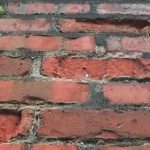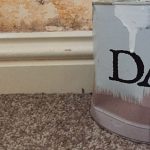The DIY Fix is reader supported. When you buy after clicking a link on our site, we may earn an affiliate commission.
In this article we will be looking at how you can identify if your damp proof course has failed. This will involve how you can identify this issue yourself. As well as why you might want to hire a professional damp surveyor to diagnose the problem.
The signs of a failed damp proof course include:
- Damp near ground level. This will often look like tidemarks as the damp soaks up through the wall. Rising damp can travel up to around 1.5 meters, so these tide marks can be significant.
- Hygroscopic salts. These are salts that are drawn through the pours in the brickwork. They will come through the surface of your wall and form white fluffy deposits along the damp tidemarks.
Hygroscopic salt deposits are far more common in rising damp, than with penetrating damp. This is because, there are far more salts in the ground, than can be naturally found in the brickwork. This means that the salt deposits will often be far more noticeable with rising damp. - Damage to skirting boards. As the water rises from the ground, it will meet decorative features such as your skirting boards. This can lead to dampening of the timber and mould and wet rot can form over time
- Blistering paint and peeling wallpaper. As the damp soaks through the surface of your walls, this will cause significant damage to decorations. You are likely to see damage to paint, including blistering, peeling, and flaking. For wallpaper, this will become damp and start to peel away.
- Mould growth. As with any form of damp, mould is not far away. If your walls remain damp this will provide the perfect situation for mould to form and spread. Not only does this look terrible and damage your decor. But it can also be harmful to health.

Should you try to identify a failed damp proof course yourself?
Rising damp can be a major issue and it can cause serious damage if it is not fixed. However, it is also the most misdiagnosed type of damp.
As a homeowner, it can be difficult to confirm with 100% confidence, that your damp proof course has failed. This mainly comes down to experience. The average homeowner does not usually have a huge amount of experience identifying rising damp.
It is also commonly misdiagnosed by professional companies. This could also be mistaken identity. But there are also some dishonest companies out there, that will diagnose rising damp because it is a more profitable job for them.
At this stage we should point out, there are many reputable damp proofing companies out there. These companies would never misdiagnose a problem just for financial gain. However, this kind of thing does go on. Therefore, we generally do not recommend free damp surveys.
Many damp companies will offer free damp surveys. But this is usually just a foot in the door. The company knows they will be recommending treatments that will make up for the free survey.
It is far better to hire an independent damp surveyor. This is not that expensive, and a standard damp survey is usually quite affordable. Because the service is completely unbiased, and they have no ulterior motive. They will offer you a detailed report with exact recommendations to fix your issue.
Allowing for this small upfront cost can save you a significant amount of money in the long run.
It is also possible to get very competitive rates on damp surveys by using online comparison sites. A popular one we like is Bark, they allow you to get up to 5 quotes from local damp surveyors. The professionals also have profiles and reviews, so you can make sure you hire someone who has been highly rated.
Prices can also end up being significantly lower, because all the surveyors are competing for your business.
To get up to 5 online damp survey quotes click here
Common treatments when your damp proof course has failed
Fixing a damp proof course can be done in a few different ways. The main techniques for fixing this issue can be seen below:
- Replacing the original DPC. This is a big job, but there are people that would argue it is the most affective. Essentially, this involves replacing the original damp proof course. The process involves removing bricks and adding a brand new DPC.
This is no small task and involves major structural work to your property. This means it is usually an expensive job. In most cases it is slightly overkill and there are easier cheaper solutions. - Chemical damp proof course. This method is probably the most popular. It can be done by professionals, or as a DIY project and it is not that complicated. It involves the injection of a damp proof cream into the mortar joint where your DPC should be located.
Once injected, the cream works its way through the pours and capillaries in the mortar and brickwork to form a waterproof barrier. This can be extremely effective and should last for decades after it has been installed. - Damp proof rods. These rods are a variation of an injected DPC. The main difference is the rods are solid when inserted. Once they are inserted into the wall, they begin to release silicone based active ingredients. Just like the cream this spreads through the masonry work, via capillary action. The result is an impermeable waterproof barrier.
The good thing about options 2 & 3, is they can both be DIY projects. If you are a reasonably competent DIY’er you may want to tackle this job yourself.
This is another reason a damp survey can be a great option. The surveyor will identify the exact issue and then recommend how to fix it. Following this you can choose one of the DIY methods to inject a new DPC.
This can end up being much cheaper than having a free survey and letting a damp company do the work for you.
Again, if you want to get up to 5 damp survey quotes click here. It is no obligation, and the quotes will all be from professional local surveyors.
Conclusion
If you think your damp proof course has failed, you will need to do some investigation to make sure this is the issue. Misdiagnosis is quite common, so you should rule out any other potential issues, such as outside defects causing penetrating damp.
If in doubt, you should always turn to a professional. In many cases this can be the most cost effective way of reaching a solution. A surveyor will be extremely thorough, and you will be left in no doubt of the exact problem.
Either way, fixing your damp problem as early as possible should be your main goal. In the long term untreated damp can cause lots of more serious problems. Including damage to your property and even health issues. So, it is very important to nip it in the bud early.




